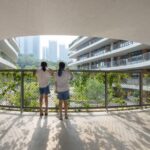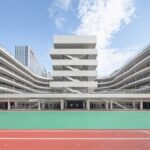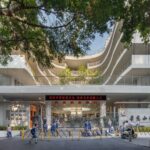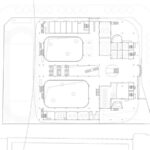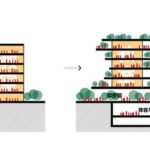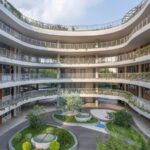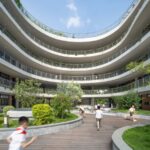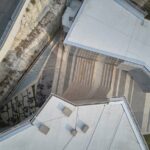The Challenge of Urban Density
As urban populations continue to surge, the challenge of designing educational spaces in high-density environments becomes increasingly pronounced. Unlike in the past, where schools were often situated in low-density areas with ample ground space for outdoor activities, modern urban landscapes pose unique constraints. The rise in building heights inevitably limits access to outdoor spaces on ground levels, presenting a significant obstacle to the holistic development of students.
Context: JingLong Elementary School

Situated in the bustling Futian district of central Shenzhen, JingLong Elementary School grapples with the realities of urban density. Surrounded by towering residential complexes, the school’s compact site necessitates innovative design solutions to address the limitations imposed by vertical space constraints. With a considerable student body comprising 36 classes, the challenge lies in providing adequate outdoor recreation areas within the confines of a six-story structure.
Innovative Design Solutions
Bringing the Outdoors Indoors
Atelier FCJZ tackles the dilemma of limited outdoor space by reimagining traditional building design. Instead of confining students to indoor classrooms during breaks, the architects propose integrating open-air environments on each floor. Positioned at the heart of the building, these semi-enclosed spaces serve as covered playgrounds, allowing students to engage in physical activities and social interactions regardless of weather conditions. Furthermore, these flexible areas double as open classrooms, fostering dynamic teaching methods and collaborative learning experiences.
Fostering Community Interaction
By decentralizing outdoor spaces and dispersing them across multiple levels, the design creates a network of interconnected micro-plazas within the school. These semi-outdoor environments not only provide students with opportunities for recreation but also serve as hubs for community engagement. Encouraging spontaneous interactions and socialization, these vibrant spaces contribute to the cohesive fabric of the school community.
Vertical Landscape Integration

Recognizing the vertical constraints of the site, the architects embrace innovative landscaping techniques to maximize greenery within the built environment. Utilizing wire mesh handrails on each level, the design facilitates the vertical growth of climbing plants, effectively integrating greenery into the architectural façade. This vertical landscape strategy not only enhances the aesthetic appeal of the school but also promotes environmental sustainability and biodiversity.
Conclusion
The design of JingLong Elementary School exemplifies a paradigm shift in educational architecture, where innovative solutions are employed to overcome the challenges of urban density. By redefining traditional spatial boundaries and integrating outdoor environments within the built structure, Atelier FCJZ creates a dynamic learning environment that prioritizes holistic student development and fosters a sense of community. Through thoughtful design interventions, the school emerges as a beacon of innovation, offering a compelling model for educational spaces in high-density urban contexts.


